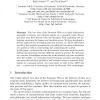IJCAI
2003
14 years 26 days ago
2003
The promise of dynamic selection of business services and automatic integration of applications written to Web Services standards is yet to be realized. This is partially attribut...
IADIS
2003
14 years 26 days ago
2003
The objective of our work is to provide some aid to the maintenance of a web site. The webmaster would like to get a semantic follow-up of the users’ browsing, but he only has a...
IADIS
2003
14 years 26 days ago
2003
The desideratum for the concept of a semiotic web is proposed. It combines both the recent semantic web and the pragmatic web initiatives but surpasses them in being faithful to C...
IJCAI
2001
14 years 27 days ago
2001
A new approach for constructing pseudo-keywords, referred to as Sense Units, is proposed. Sense Units are obtained by a word clustering process, where the underlying similarity re...
LAWEB
2004
IEEE
14 years 27 days ago
2004
IEEE
Model-based design methods, and model-based architectures, have gained adoption in authoring applications for the WWW. This is further reinforced by the increasing visibility of t...
IIWAS
2004
14 years 27 days ago
2004
Abstract: To enable efficient access to multimedia content, the media data has to be augmented by semantic metadata and functionality. The semantic representation has to be integra...
IFIP12
2004
14 years 27 days ago
2004
With the evolution of Web service technology, services will not only become increasingly sophisticated, but also move into the area of business-to-consumer and peer-to-peer interac...
BXML
2003
14 years 27 days ago
2003
: The Web service architecture promises to be highly dynamic. The idea is that a service requester can discover a needed service at runtime. Due to the fact that this discovery pro...
BNCOD
2001
14 years 27 days ago
2001
The core idea of the Semantic Web is to make information accessible to human and software agents on a semantic basis. Hence, web sites may feed directly from the Semantic Web explo...
ACL
2001
14 years 27 days ago
2001
The standard pipeline approach to semantic processing, in which sentences are morphologically and syntactically resolved to a single tree before they are interpreted, is a poor fi...




